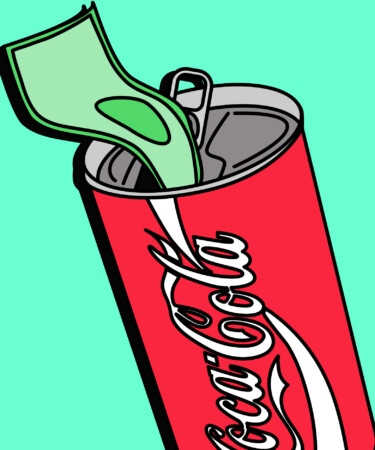This article is part of our Cocktail Chatter series, where we dive into the wild, weird, and wondrous corners of history to share over a cocktail and impress your friends.
It’s no secret that the Coca-Cola Company and PepsiCo have a long-standing feud. Launched in 1886, Coca-Cola was marketed as a carbonated cure-all for myriad ailments. It was an immediate hit with consumers. Inspired by the success of the syrupy soda, fellow pharmacist Caleb Bradham launched his own “temperance drink” called Brad’s Drink in 1893 before renaming it Pepsi-Cola five years later. After being adapted into the soft drink we know today, Coca-Cola remained the preferred choice for most consumers. But in 1975, Pepsi-Cola launched “the Pepsi Challenge,” which revealed that during a blind tasting, most people actually preferred Pepsi over Coca-Cola.
In an attempt to gain back its lost market share, the Coca-Cola Company introduced low-calorie Diet Coke in 1982; the eventual flop that was the needlessly reformulated New Coke in 1985; and a marketing campaign that would last a meager three weeks: the MagiCan.
Debuted on May 7, 1990, the MagiCan contest was intended to be a multi-million-dollar giveaway and an integral part of Coca-Cola’s “Magic Summer ‘90” promotion and sponsorship of the New Kids on the Block’s Magic Summer Tour. Each MagiCan was designed to look and feel like a standard Coke can, but rather than being filled with soda, the cans were loaded with hidden prizes such as rolled-up bills or vouchers for heftier prize money. The prizes inside every MagiCan were contained in a spring-loaded, water-tight compartment that was intended to bounce to the top of the can once its tab was pushed down. But instead of filling the cans with soda, Coca-Cola topped off each MagiCan with foul-smelling, chlorinated water to disguise the winning vessels and dissuade consumers from actually taking a sip once the can was opened. Coca-Cola intended to randomly distribute 750,000 of the inconspicuous cans among the 200 million classic Coke cans in circulation at the time.
The campaign instantly sent Americans into a frenzy, with stories emerging of people shaking every can on the shelf at retailers in a desperate attempt to discover a MagiCan. Despite initial success, excitement soon dwindled as reports of faulty packaging began to circulate. Consumers complained of inoperative springs that left their prizes swimming in the chlorinated water, or leaking compartments that ruined the prizes even if they did bounce to the top of the can. While the company reports that it only received a total of 22 complaints, it prompted Coca-Cola to take out a full-page ad that ran in newspapers nationwide on what to do should you purchase a flawed MagiCan. An 11-year-old in Massachusetts was eventually rushed to the hospital after drinking the ammonium sulfate-spiked MagiCan water. While the boy would end up being fine — the Massachusetts Department of Health determined that the water had less chlorine than a swimming pool — the incident wrought enough negative publicity to poison the promotion. It ended on May 31, after just three short weeks.
The MagiCans, though, were never fully pulled from shelves. As the special cans’ packaging was indistinguishable from Coca-Cola Classic cans, a recall would prove impossible without removing every can of Coke from shelves nationwide. By the time the competition had come to a close, only 200,000 MagiCans had been distributed, with the remaining 500,000 left unreleased. While the MagiCan certainly gave the “Magic Summer ‘90” a rocky start — the plug had been pulled on the campaign before the North American leg of the New Kids on the Block tour had even started — Coca-Cola pivoted to giving away free tickets to shows, and even introduced a “MagiCup” at fast-food restaurants that unveiled prizes under peel-off stickers.
Despite the fiasco, it did little to damage Coca-Cola’s overall reputation. The company still takes up a whopping 46 percent of the soft drink market, nearly double PepsiCo’s 25.6 percent. So, while the campaign may have put a bad taste in consumer’s mouths — some more literally than others — Coca-Cola remains king.
